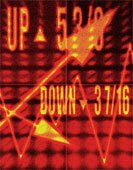 Based on recent emails, I can tell you that while a lot of readers are following my recommended Buy/Sell discipline, some of them are not. It would be interesting to know, how many of the current 18,000 readership is in tune with my approach and how many simply view it as another form of entertainment.
Based on recent emails, I can tell you that while a lot of readers are following my recommended Buy/Sell discipline, some of them are not. It would be interesting to know, how many of the current 18,000 readership is in tune with my approach and how many simply view it as another form of entertainment.
With the recent market turmoil, it pays to have a plan in place which will serve as a guide to your actions and allow you to make better investment decisions, while at the same time preventing a serious portfolio haircut should the bear market continue.
This point was brought home when I read MarketWatch’s “Keep the faith,” which focused on investors having trouble maintaining their confidence in the stock market and the economy:
Between the housing bubble, credit crisis, inflation worries, concerns over the weak dollar, the potential for the economy to drop into a recession, a stock market that seems more anxious in falling than rebounding, and more, it’s hard to believe an investor could have any faith and confidence left.
While having confidence is a good thing, it does nothing for you when it comes to your investments, unless you have a specific plan in place to deal with the uncertainties thrown at you by the economic upheaval. Unless you don’t mind becoming a repeat victim of the 2000 – 2002 bear market, you better replace blind confidence with realistic thinking about where the market is at and where it might be going.
The story goes on to suggest six reasons why you should be confident in today’s environment. While I don’t agree with most of what’s written, you may want to read them anyway. However, the bottom line refers to the same old numbers of what the stock market has returned over the past 5 years or over a lifetime.
Nowhere will you find the most important data, which is the negative effect the last bear had on more recent returns during this century. If you have accumulated substantial assets over your lifetime, and you are now somewhere in your 50s or older, don’t believe the baloney about diversification and long-term stock market returns. If a bear market has the potential to cut your portfolio value by 50% or so, that’s what you should be directing your attention to by making plans accordingly.
While no one knows whether the bear will turn out that ugly or not, you better be prepared other than simply keeping faith in the fact that over the very long term 9% returns have been accomplished. When you’re in your 50s, your time frame has been shortened considerably, and a 50% portfolio loss will have far more of an impact on your financial life than when you were in your 30s.
